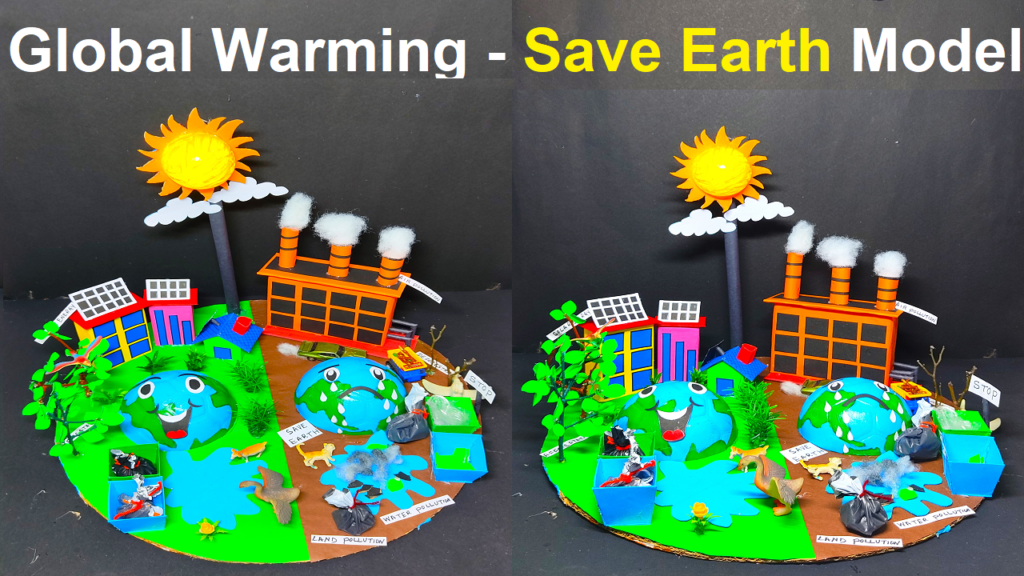Climate change is one of the most critical challenges facing our planet, and understanding its key components—global warming, the greenhouse effect, and actions to save the Earth—is crucial for promoting environmental awareness and sustainable practices.
1. Global Warming:
- Definition: Global warming refers to the long-term increase in Earth’s average surface temperature due to human activities, primarily the release of greenhouse gases into the atmosphere.
- Causes: The burning of fossil fuels, deforestation, industrial processes, and agricultural practices contribute to the buildup of greenhouse gases, such as carbon dioxide (CO2), methane (CH4), and nitrous oxide (N2O).
- Consequences: Rising temperatures lead to climate-related changes, including more frequent and severe heatwaves, melting ice caps and glaciers, altered precipitation patterns, and disruptions to ecosystems.
2. The Greenhouse Effect:
- Definition: The greenhouse effect is a natural process that warms the Earth’s surface. Greenhouse gases in the atmosphere trap some of the energy from the sun, preventing it from escaping back into space.
- Role of Greenhouse Gases: While essential for maintaining a habitable temperature on Earth, human activities have intensified the greenhouse effect by increasing the concentration of these gases, enhancing the natural warming process.
- Impact on Climate: Excessive greenhouse gas emissions result in an enhanced greenhouse effect, leading to global warming and climate change.
3. Actions to Save the Earth:
- Individual and Collective Responsibility: Addressing climate change requires both individual and collective efforts. Each person plays a role in reducing carbon footprints and advocating for sustainable practices.
- Renewable Energy: Transitioning from fossil fuels to renewable energy sources, such as solar and wind power, is critical for reducing greenhouse gas emissions and mitigating climate change.
- Reforestation and Conservation: Planting trees and preserving existing forests help absorb CO2, mitigating the impacts of deforestation and enhancing carbon sequestration.
- Energy Efficiency: Implementing energy-efficient practices, such as using energy-saving appliances and adopting sustainable transportation options, contributes to reducing overall energy consumption.
- Waste Reduction: Proper waste management, recycling, and reducing single-use plastics help minimize environmental pollution and the release of harmful gases.
- Advocacy and Education: Raising awareness and advocating for policies that address climate change are essential components of a comprehensive strategy to save the Earth.
In conclusion, global warming, the greenhouse effect, and actions to save the Earth are interconnected aspects of a complex environmental challenge.
Creating a model to illustrate global warming, the greenhouse effect, and actions to save the Earth can be an engaging and educational science project.

Here’s a step-by-step guide to help you build a simple yet effective model:
Materials:
- Large cardboard or foam board (for the base)
- Blue and green construction paper (for the Earth)
- Clear plastic sheet or cling film (for the greenhouse effect)
- Small toy animals or cutouts (optional)
- Glue or tape
- Marker or paint
- Scissors
- LED lights (optional, for added visual effects)
global warming – greenhouse effect – save earth model making Instructions:
- Prepare the Base:
- Cut a large circle from the cardboard or foam board to represent the Earth’s surface.
- Create the Earth:
- Cover the cardboard circle with blue construction paper to represent the Earth’s oceans. Cut out and glue or tape green construction paper in the shape of continents on top of the blue base.
- Add Greenhouse Effect:
- Cut a piece of clear plastic sheet or cling film into a rectangular shape. Attach it over the Earth, leaving one edge unattached to represent the greenhouse effect.
- Label and Decorate:
- Use a marker or paint to label your model with relevant terms such as “Earth,” “Greenhouse Effect,” and “Global Warming.” Decorate the Earth with features like mountain ranges, rivers, and deserts.
- Place Small Animals (Optional):
- If you have small toy animals or cutouts, place them on the Earth to represent the impact of global warming on ecosystems.
- Add LED Lights (Optional):
- For added visual effects, you can attach LED lights inside the model to represent the energy from the sun. Place the lights strategically to demonstrate how the greenhouse effect traps some of this energy.
- Explain the Model:
- During your presentation or exhibition, explain the different components of your model. Emphasize how the greenhouse effect works, leading to global warming, and the potential consequences for the Earth’s climate and ecosystems.
- Include Tips to Save the Earth:
- Attach small signs or banners with tips to save the Earth, such as reducing carbon emissions, conserving energy, planting trees, and practicing sustainable habits.
- Interactive Element (Optional):
- If possible, create an interactive element where viewers can pledge or share their ideas on how to contribute to saving the Earth. For example, you can provide small cards for people to write down their eco-friendly commitments and attach them to the model.
- Encourage Discussion:
- Engage your audience by encouraging discussions about the impact of human activities on the environment and the importance of taking collective action to address climate change.
This model serves as a visual representation of the greenhouse effect, global warming, and the need for environmental conservation. It provides an opportunity for education and discussion about the importance of sustainable practices to save the Earth.

